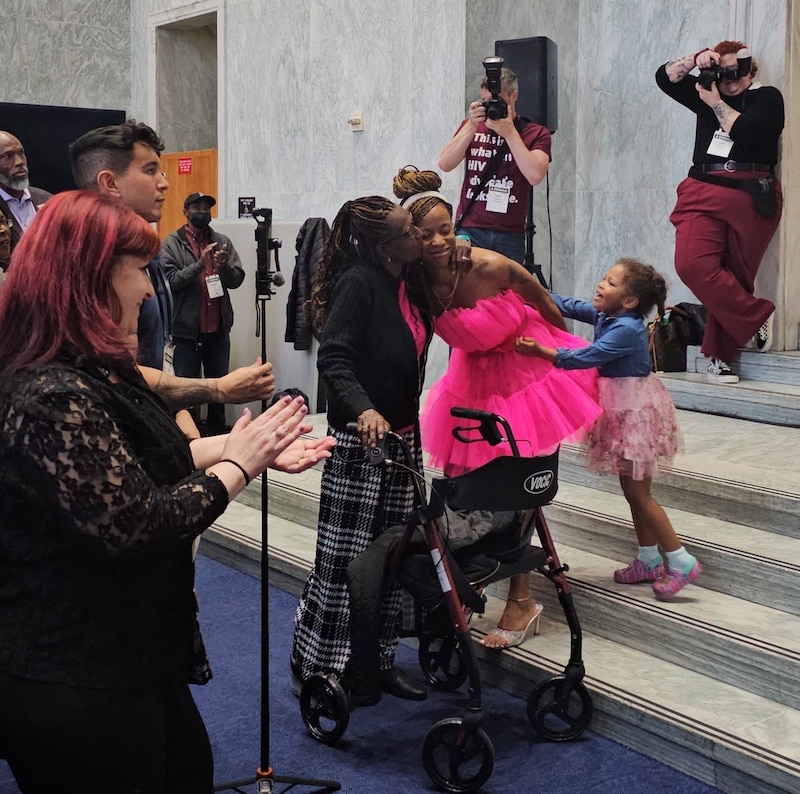Public health, explained: Sign up to receive Healthbeat’s free Atlanta newsletter here.
The sharp job cuts at the Centers for Disease Control and Prevention include a successful program reducing HIV transmission to babies. Over the past 30 years, the number of infant HIV cases has fallen dramatically.
Research published by Margaret Lampe, a CDC epidemiologist, found that from 1994 to 2020, the number of HIV transmissions to babies was cut by 97%, largely through pregnant women with the disease taking antiretroviral drugs.
That prevention work, experts say, may be jeopardized in the wake of job cuts at the division of the CDC that works on HIV prevention. Five of 10 HIV branches have been eliminated by last week’s massive cuts at the U.S. Department of Health and Human Services. It resulted in about 150 people losing their jobs.
HIV transmissions to babies still occur: Last year, an Atlanta HIV clinic saw three new children born with the disease.
“We see them every year,” said Dr. Brian Zanoni, medical director of the Ponce Family and Youth Clinic at Grady’s Ponce de Leon Center. “Every single child in the United States born with HIV is a tragedy and a failure of the medical system.”
“And already in 2025 we’ve had one new infection,” said Zanoni, who is also an associate professor of pediatrics at Emory School of Medicine.
Given the funding cuts, “We’re likely to see HIV rates increase,” Zanoni said. “When HIV rates increase, then children born with HIV are going to increase.”
Overall, the 2,400 CDC personnel whose jobs were terminated last week represent a heavy blow to the country’s public health efforts, experts said. The CDC cuts are part of the restructuring at the HHS that involves eliminating about 10,000 employees. Besides HIV, other CDC areas absorbing big cuts included divisions involving workplace health and safety, injury prevention, reproductive health, smoking, and violence prevention, CNN reported.
If the overall HIV funding is not restored, “new infections will at least remain where they are or go up again; we will see more infections, more illness, and more costs,” said Dr. John Brooks, former chief medical officer of the Division of HIV Prevention who retired about six months ago.
“There are several estimates of how much lifetime HIV care costs in 2024, between a low of $540,000 up to over $1 million per patient,” Brooks said. “That could result in up to $30 billion in annual expense just to treat people if infection rates continue as they are.”
Zanoni has worked on HIV in South Africa, where transmission rates to babies are higher.
“Prevention makes sense, and it’s cost-effective,” Zanoni said. “If you can prevent a few of these infections, you’re saving millions of dollars” in treatment and medical costs.
The prevention work for perinatal HIV transmissions has included engagement and communication with health care providers and public health departments, funding for early diagnosis and treatment, and data analysis.
CDC officials have also been working on preventing syphilis transmission to babies, which has more than tripled in recent years, with more than 3,800 cases reported in 2023 alone.

Antoinette Jones of Atlanta, 30, was born with HIV. But with the help of antiretroviral drugs, her daughter was born without the disease.
She welcomed an HHS panel’s updating of guidelines on breastfeeding for parents with HIV last year.
“A lot of the work on mother-to-child transmission came from actual advocates on the ground who are living with HIV,” said Jones, who is co-founder of Dandelions Inc., an advocacy group for people who identify as lifetime survivors of HIV.
She said CDC officials “were listening, and went back to restructure and rework the way that they were trying to do things.”
The agency’s job reductions could even impact the first Trump administration’s program to target HIV in areas hard hit by the disease, Brooks said. “Trump wisely invested and committed the federal government to Ending the HIV Epidemic, and Kennedy’s cuts could sabotage everything,” he said.
In the wake of the massive health agency shakeup, Health and Human Services Secretary Robert F. Kennedy Jr. said about a fifth of the cuts likely were “mistakes,” saying last week: “We’re reinstating them. And that was always the plan,” he said.
Andy Miller is a freelance consultant and reporter for Healthbeat. Rebecca Grapevine is a reporter covering public health in Atlanta for Healthbeat. Contact Rebecca at rgrapevine@healthbeat.org.







